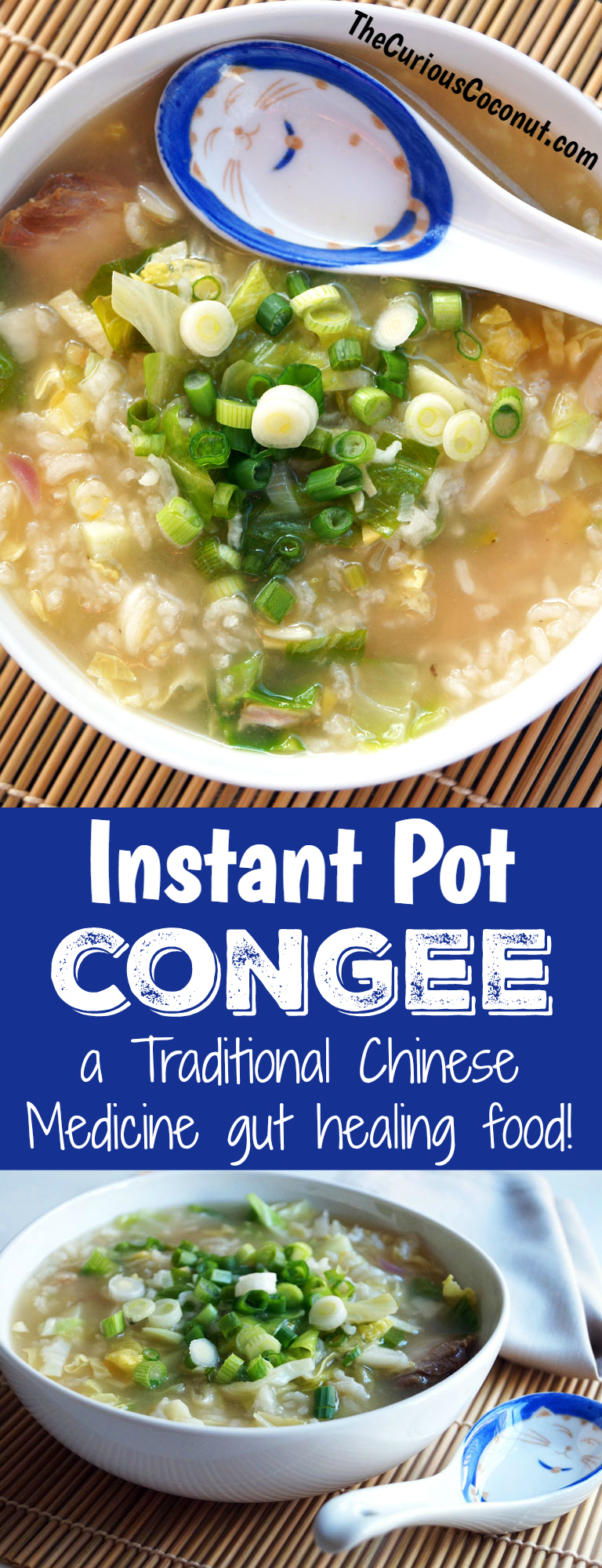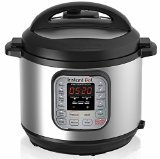Congee is a traditional gut-healing food in Chinese Medicine. Learn how to easily make it in your Instant Pot pressure cooker // TheCuriousCoconut.com
Congee is a traditional gut-healing food in Chinese medicine made from short grain white rice and copious amounts of bone broth.
Let me cut the haters off right here: yes, congee is made from a grain. White rice. If you follow the Loren Cordain (dogmatic) version of Paleo, then you don't eat grains, including rice and congee, on a Paleo diet. Just keep moving if you're not interested in this traditional healing food from Chinese Medicine.
But lots of people, including myself and other experts and respected voices in the Paleo community have found that some leniency makes for a more sustainable and nourishing long-term lifestyle.
Does rice have a place in the Paleo diet?
I say: yes it does. And I am certainly not alone here on #TeamWhiteRice. I didn't always think this way, though.
I've really broadened my horizons since starting my health journey in 2010. At first, I was dogmatic about diet being the answer, since I saw such tremendous and rapid results from diet change.
When my results would stall the answer was "well, I just need to be 100% strict Paleo." This eventually became 100% strict AIP, and now 6 years in I'm so much wiser and know that diet is not The One Thing with which to cure yourself.
It was about 3 years into my journey that I quit being so stubborn and realized that I needed medical attention in order to overcome IBS, leaky gut syndrome, and chronic fatigue. I turned to the ancestral wisdom of Chinese Medicine and have really gone all in with this form of medicine to address my health concerns these last 3 years.
The beautiful thing about Chinese Medicine is that it takes the individual--past and present--into account and aims to treat the root cause of your illness. Acupuncture and herbal prescriptions are based on the unique history of the person, not just their symptoms.
You and I could both have a similar constellation of symptoms that a Western doctor might treat identically, but a Chinese Medicine doctor may use completely different acupuncture points and herbs, since we are individuals and the root cause of our problems is likely different.
It's common for an acupuncturist to ask questions as far back as when your parents were trying to conceive you.....talk about a detailed medical history!
They will also ask questions about your whole lifestyle, not just physical symptoms. How are you sleeping? What is your mood like? How is your appetite? Do you get exercise? If you are a cycling woman, what is your cycle like?
Congee and Chinese Medicine
Congee is a traditional healing food in Chinese Medicine that is extremely easy to digest. I've seen over half a dozen acupuncturists since 2013 and every single one of them has told me congee would be a great food for me to add to my diet. I regret that I waited until 2015 to try it out!
Damn diet dogma....I was so stubborn about making rice a regular part of my diet, against multiple doctor's recommendations, because "it's not Paleo". UGH. Well, it's part of my personalized Paleo, as you will. Chris Kresser (HEY he's an acupuncturist!) is the big proponent of this concept, and I think it's great!
Congee has become a staple food in my diet these last 6+ months, although I'm eating less of it now that spring is here (it is definitely more of a winter food). And I don't give a damn that it's not Paleo, because it is good for me and works with my body right now.
A big bowl of congee for breakfast feels good, tastes good, and fuels me until lunch.
It is also a great way to pack in a hefty dose of homemade bone broth. If you're looking for the easiest bone broth recipe ever, check out my tutorial for making bone broth that gels in the Instant Pot.
Congee and the Stomach/Spleen (Earth Element)
It's beyond the scope of a recipe post to dive into Chinese Medicine theory, but I'll provide you with some links and books you can check out to learn more. I'd also like to write more about Chinese Medicine here on the blog, too, if you're interested in that! Very briefly, Chinese Medicine identifies 12 major organ systems and categorizes them into 5 elements:
• Water: Bladder & Kidney
• Wood: Gallbladder & Liver
• Fire: Small Intestine, Heart, Pericardium, San Jiao (aka "Triple Burner", you can think of this as hormones, metabolism)
• Earth: Stomach & Spleen (Pancreas)
• Metal: Large Intestine & Lung
I just want to point out that I KNOW this can sound very strange when you're first exposed to it, but please remember that I am a highly skeptical scientist. Neuroscientist, actually. And, using my critical scientist brain I've arrived at a place where I put my trust in this ancient medicine. It's not woo woo. The World Health Organization (WHO) and National Institutes of Health (NIH) agree.
So, in Chinese Medicine, the spleen, pancreas, and stomach need to be able to transform and transport the food that you eat so that it may nourish your body. The best way to help these organs have the easiest job possible is to eat warm, easy to digest, soupy foods.
Cold and raw foods make their job the hardest. If you have a robust, strong digestion, then cold and raw foods are OK. But, so many of us who are drawn to Paleo and especially AIP have compromised digestion in some way, so anything we can do to make digestion easier will only help our health.
Congee is the go-to food in Chinese Medicine for those suffering many digestive woes. It is an excellent way to consume healing broth, too. Some acupuncturists will even prescribe certain herbs to cook in your congee, although I have never done that. I always take my herbal prescription as a separate tea away from meals.
Tips and ideas for congee
You can make congee on the stovetop, but you have to keep an eye on the pot for several hours. I did this for a while, and then I decided to try out the porridge setting on my Instant Pot instead. It works like a dream and saves me from having to remember to stir a pot.
The amount of broth you use will determine whether your congee is thin and soupy or thick and hearty. I like mine both ways and typically make it somewhere in the middle.
I like to use either ground pork or chicken and cabbage to round out the congee and make it a complete meal. Sometimes I also use aromatics like celery, carrots, even turnips and radishes too.
I like to keep seasonings simple with just onion, garlic, salt, pepper, and ginger with a green onion garnish when served. A splash of fish sauce and/or coconut aminos can be a nice garnish as well if you like those.
Use short grain rice (like sushi rice) when making congee - longer grained rice does not work well in congee and does not produce the correct silky texture.
Further reading and resources about Chinese Medicine
I wrote an in depth blog post about using Chinese medicine to heal from uterine fibroids and endometreosis here.
In my episode on the Balanced Bites podcast I talk a lot about Chinese medicine.
You can also browse these websites:
How to Make Congee in the Instant Pot Pressure Cooker (gluten-free)
Published 04/03/2016
Congee is a traditional healing rice porridge used in Chinese Medicine. Learn how to quickly and easily make it in your Instant Pot Pressure cooker! You can play around with the ingredients to suit your tastes - this is just one combination I really enjoy.
Ingredients
- 1 TB lard or fat of choice
- 3 ribs celery, sliced thin
- 1 small turnip, peeled and diced
- 2-3 radishes, diced
- 1 large shallot or small onion, diced
- 1 pound of ground chicken or ground pork. May also use shredded cooked chicken or pork.
- 6-10 cups homemade bone broth - any variety (I prefer chicken)
- 1/2 to 1 TB coarse unrefined salt (if your broth is salted, use less)
- 1 to 1-1/2 cups short grain rice, rinsed until water is clear
- 1-2 TB grated fresh ginger
- 2-4 cups shredded cabbage (SAVE THIS until the very end)
- green onions to garnish
- optional: fish sauce and/or coconut aminos to taste
For the broth - yes, that is a wide range for the broth! Use less for a thick, rich congee and more for a watery, soupy dish. I personally prefer a ratio of about 8 cups water to 1 and 1/2 cups rice.
For the meat - I have tried browning the meat in a separate pan, then adding it to the rice; browning the meat in the Instant Pot insert and then adding the rice and cooking; and adding the raw meat and letting it cook with the rice. They all taste basically the same to me, and just putting the raw meat in with the uncooked rice is by far the easiest method, so that's what I normally do.
Instructions
- Begin by rinsing your rice until the water runs clear.
- Press the saute button on the Instant Pot and then the "more" button. Melt the fat in the pot and add the aromatics. Cook about 3 min, until soft and fragrant. Turn off the Instant Pot.
- Add the ground chicken or pork, salt, ginger, and the rinsed rice and stir to combine with the aromatics. Pour in broth.
- Attach the lid, close the vent, and press the "porridge" button on the Instant Pot. It will take about 1 hour for it to pressurize, cook, and depressurize.
- Stir the cooked congee and break up any large chunks of meat that cooked together. Stir in the shredded cabbage - it will wilt down and cook enough from the residual heat in the pot. Serve with a garnish of green onion slices and a splash of coconut aminos and/or fish sauce to taste.
- Keeps well in the fridge for up to 5 days. Reheat in a 350F oven or in a pot on the stovetop.
Cook time: 00 hrs. 20 mins. (in reality about 60 for pressurization/depressurization)
Total time: 70 mins.
Recommended Tools & Ingredients
These are affiliate links to the very products I trust in my own kitchen. I only link to products that I truly love!


























Chicken and dumplings with a Puerto Rican twist: the dumplings are made from green plantains, making them gluten-free, Paleo, and Whole30. The broth is infused with bold flavor from the authentic sofrito, made with garlic, culantro, oregano, red bell pepper, and onion.